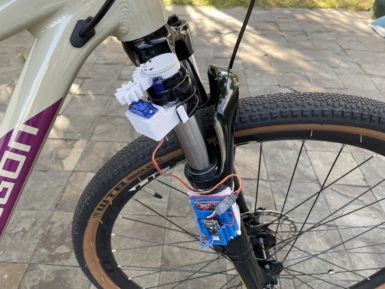
Make Your UNO Soldering Bundle
With this bundle you have all the tools and components needed to follow the experience of building your very own Arduino UNO and the synth shield.
Overview
Begin your journey to become a maker with the Make Your UNO Soldering Bundle, which includes the Arduino Make Your UNO Kit and all the needed tools to build a soldering station at home.
With the Arduino Make Your UNO Kit you will learn the basics of electronics by assembling your Arduino UNO and become familiar with soldering by mounting every single component.
The Arduino Soldering Kit contains all the tools and safety gear needed to set your very own soldering station. The temperature of the soldering iron included in this kit can be adjusted within the range of 200°C to 450°C. Additionally, it has an easy-to-use mechanism to exchange the soldering tips.
Tech specs
The Soldering Kit includes:
- 60 Watts - 220V soldering iron with adjustable temperature
- 5 tips for soldering iron
- 1 stand for soldering iron
- Lead-free solder wire
- Safety glasses
- Wire cutter
- Precision Tweezers
The Arduino Make Your UNO Kit contains:
- Arduino Make Your UNO
- 1 x Make Your UNO PCB
- 1 x USB C Serial adapter Board
- 7 x Resistors 1k Ohm
- 2 x Resistors 10k Ohm
- 2 x Resistors 1M Ohm
- 1 x Diode (1N4007)
- 1 x 16MHz Crystal
- 4 x Yellow LEDs
- 1 x Green LED
- 1 x Push-Button
- 1 x MOSFET
- 1 x LDO (3.3V)
- 1 x LDO (5V)
- 3 x Ceramic capacitors (22pF)
- 3 x Electrolytic capacitors (47uF)
- 7 x Polyester capacitors (100nF)
- 1 x Socket for ATMega 328p
- 2 x I/O Connectors
- 1 x Connector header 6 pins
- 1 x Barrel jack connector
- 1 x ATmega 328p Microcontroller
- Arduino Audio Synth
- 1 x Audio Synth PCB
- 1 x Resistor 100k Ohm
- 1 x Resistor 10 Ohm
- 1 x Audio amplifier (LM386)
- 1 x Ceramic capacitors (47nF)
- 1 x Electrolytic capacitors (47uF)
- 1 x Electrolytic capacitors (220uF)
- 1 x Polyester capacitor (100nF)
- 4 x connectors pin header
- 6 x potentiometer 10k Ohm with plastic knobs
- Spare parts
- 2 x Electrolytic capacitors (47uF)
- 2 x Polyester capacitor (100nF)
- 2 x Ceramic capacitors (22pF)
- 1 x Push-Button
- 1 x Yellow LEDs
- 1 x Green LED
- Mechanical parts
- 5 x Spacers 12mm
- 11 x Spacers 6mm
- 5 x screw nuts
- 2 x screws 12mm
Resources for Safety and Products
Manufacturer Information
The production information includes the address and related details of the product manufacturer.
Arduino S.r.l.
Via Andrea Appiani, 25
Monza, MB, IT, 20900
https://www.arduino.cc/
Responsible Person in the EU
An EU-based economic operator who ensures the product's compliance with the required regulations.
Arduino S.r.l.
Via Andrea Appiani, 25
Monza, MB, IT, 20900
Phone: +39 0113157477
Email: support@arduino.cc
Documentation
Get Inspired
Arduino based bicycle movement sensor and GPS tracker.

… magnetic reed switch, but building the game himself in Unity. He had to construct and animate models for himself, the bike, and the scenery. After adding an AI and ranking system to the game, he was able to successfully race within the virtual environment on a real bike. Responsive LED system Motivated by the desire for a more advanced lighting system while on her nighttime bike rides, Natasha (TechnoChic) decided to affix strips of NeoPixel LEDs all over her bike that could react to music in real-time. The LEDs are controlled by an Arduino Nano 33 IoT that is, in turn, connected to her boombox via a 3.5mm audio jack for reading the audio signal. Two additional Nano 33 IoT boards were used for the wheels, along with more NeoPixels and batteries for each. GPS tracker Bicycle theft has been rapidly increasing over the last couple of years, which is why being able to recover a stolen bike has become vital. Johan’s bike tracker project contains an Arduino MKR GSM 1400 which reads motion data from an IMU and uses it to determine if the bike has moved when it is not supposed to. Once movement is detected, the board reads GPS data from a MKR GPS Shield and sends it over an LTE data connection in real-time so that the bike can be found. Integrated safety features The majority of mountain bikes lack useful safety features such as integrated lights, turn signals, and speed tracking, which is why Collin Wentzien embarked on his “(not so) electric bike” project. He built a series of features, including automatic brake/turn lights, a headlight, and an electronic horn with the goal of improving safety. Furthermore, his bike also got a bike computer upgrade which contains an Arduino Mega, GPS module, and dual screens for displaying relevant telemetry data. Speedometer display After losing the display unit for her bike computer, Element14 Presents host Katie wanted to replace it with a DIY version that tracked the current speed







